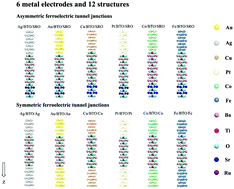Diverse polarization bi-stability in ferroelectric tunnel junctions due to the effects of the electrode and strain: an ab initio study†
Abstract
Both electrodes and substrates are factors of great significance for the performance of ferroelectric tunnel junctions (FTJs) in designing functional nanodevices. To provide a comprehensive view on the polarization stability in FTJs due to the effects of an electrode and a substrate misfit strain, in this work we calculated more than 1000 FTJ structures by utilizing an ab initio density functional theory (DFT) method, via changing the symmetry of the FTJ structure (i.e., both asymmetric and symmetric FTJs), electrodes (including Au, Ag, Cu, Pt, Co, Fe, and SrRuO3), barrier thickness (ranging from 2 to 10 unit cells), polarization direction (both positive and negative polarizations) and epitaxial strain (i.e., −3%, −2.5%, −2%, −1.5% and −1%) as variables. This shows that the FTJs can exhibit quite diverse polarization bi-stability due to the combined effect of the electrode and strain control, which indicates diverse performance of the FTJs modulated by the electrode and strain. In particular, the polarization-mediated electrostatic potential in the barriers with different electrodes forecasts an electrode-tailored tunnel electroresistance effect. Our study provides guidance on the practical applications of FTJs with regard to the selection of electrodes and substrates.



 Please wait while we load your content...
Please wait while we load your content...